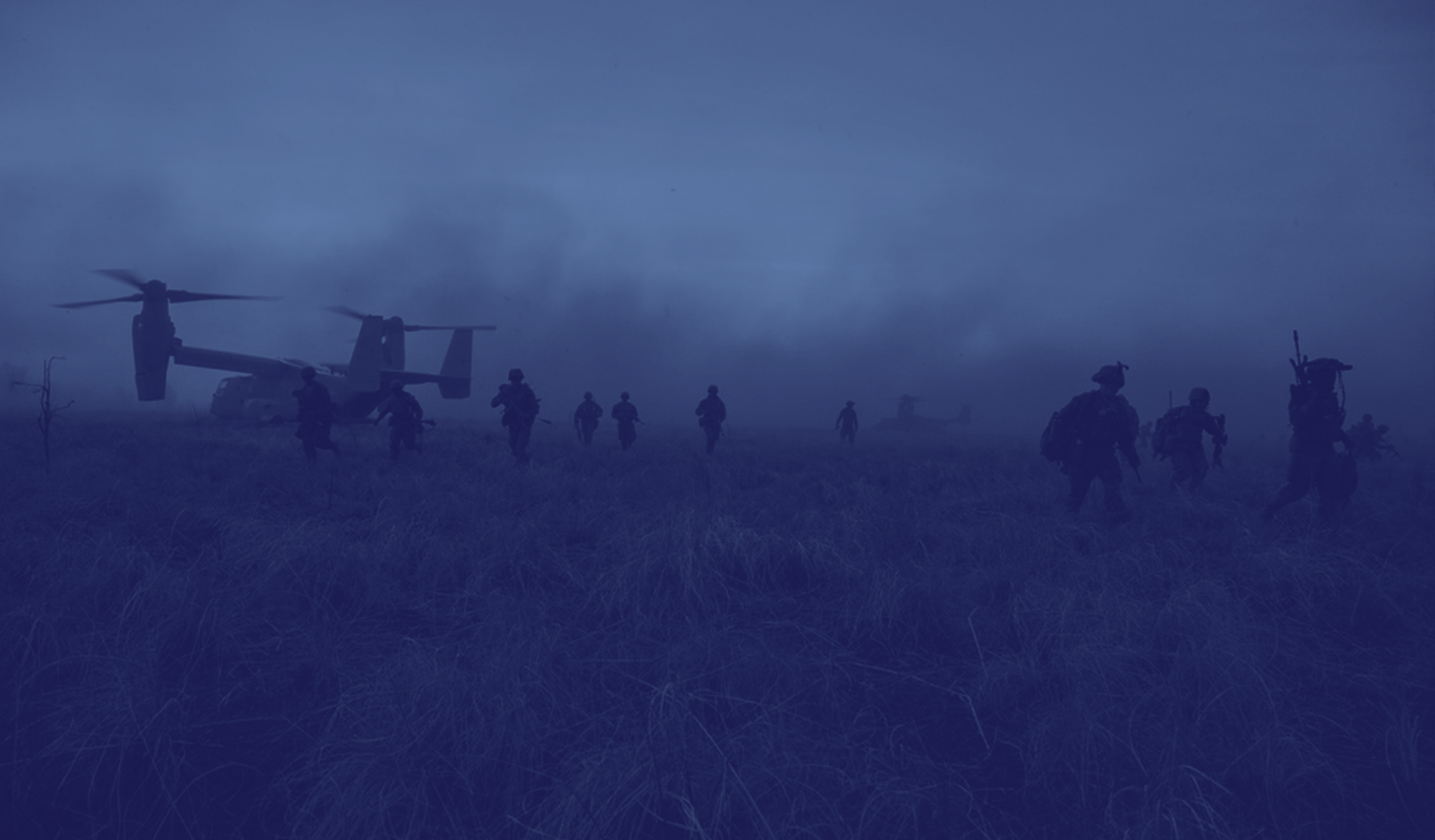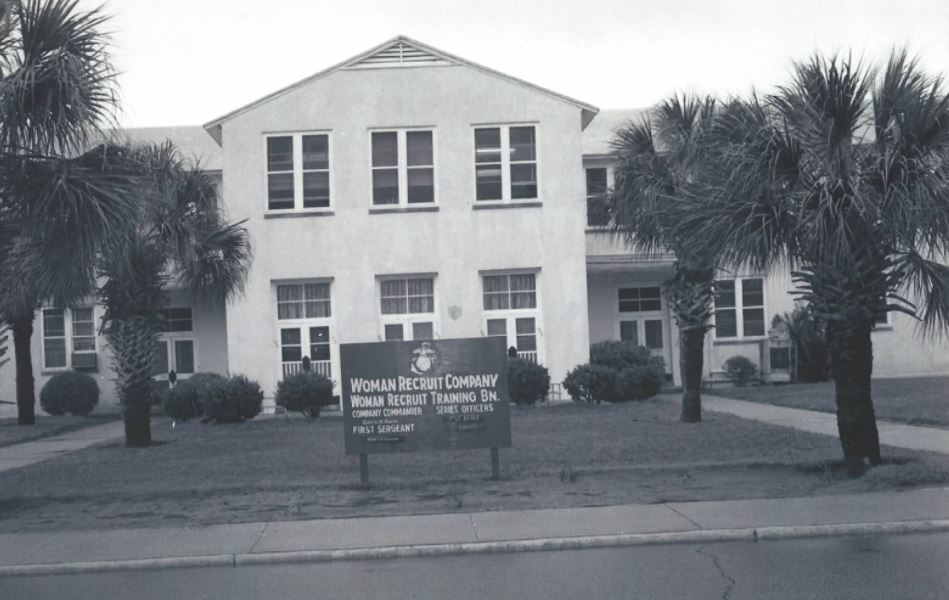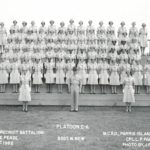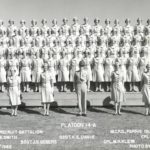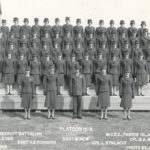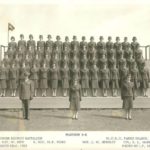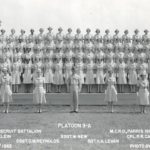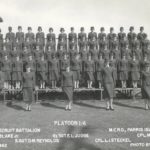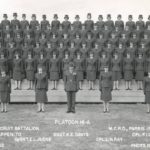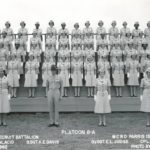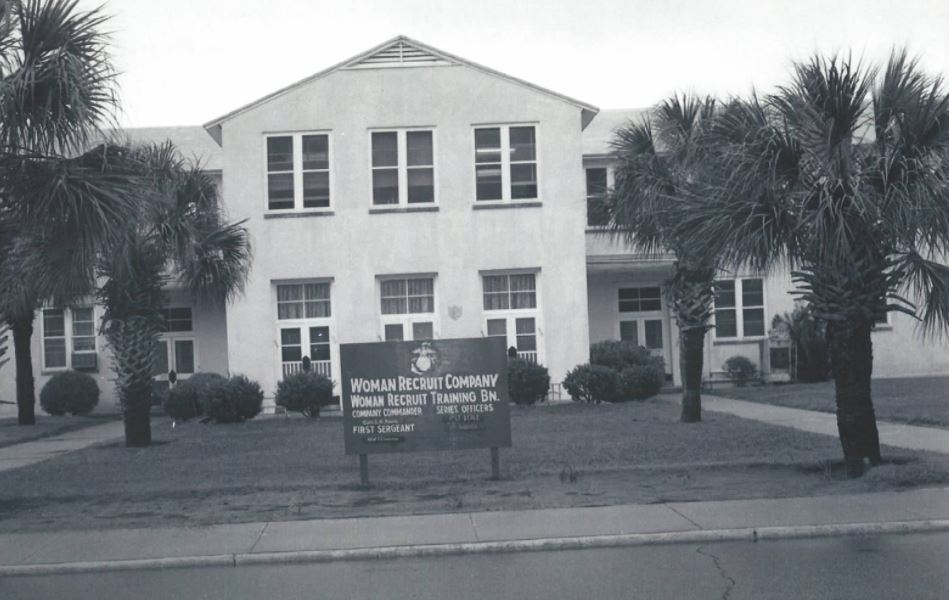
High Heeled Boots
There are several striking differences between the Women Marines’ boot camp and the men’s
ONE OF THE most widely circulated football stories relates that once when Knute Rockne’s “Fighting Irish” were trailing, he stayed out of the locker room throughout nearly all of the 15-minute half-time. Seconds before his battered team was due to take the field, he thrust his flat face through the door and said, “Oops, excuse me. I thought this was the Notre Dame team.”
His humiliated assassins tore doors off hinges raging out to redeem themselves.
It is this fierce, primeval vanity, which others call pride and we call esprit de corps, that has always been the male Marine’s most priceless asset. As it has been our heritage from our predecessors, it will also be-if we are half the men we claim to be-our legacy to our succesors.
Because esprit has been almost literally pounded into us by acid-tongued, knob-knuckled, frosty-eyed men, we find it unthinkable that the same-perhaps even a deeper-love of Corps can be imbued in dewy-eyed young females through a radically different type of initial training.
Yet Parris Island’s Woman Recruit Training Battalion does precisely that.
What mysterious alchemy transforms a confused, awkward 18-year-old girl into a poised, proud young lady in the short span of nine weeks? How close is the woman’s initial training period patterned after the man’s? The answer to these and other questions can be-found at PI, home of the only WM boot camp in the country.
But, before we journey there, let’s first see if we can clarify some of the half-truths and misconceptions which have grown up around our Woman Marines. Most people who care, know that there were women-called Marinettes-in the Corps as far back as WWI. Yet few realize how short was their service. The 305 women who enlisted as privates, with a maximum attainable rank of sergeant, served only from August, 1918, until July, 1919 less than a year.
A quarter of a century was to pass before, in February, 1943, patriotic women by the thousands again enlisted in the Marine Corps. Within 15 months, their number had grown to 18,000 enlisted and 821 officers. The vanguard, numbering 722, received a month’s recruit training at Hunter College, N.Y., under the auspices of the U.S. Navy. By July, 1943, the Corps had established its own woman’s boot camp at Camp Lejeune, which operated throughout the duration of WWII.
The term, Marinettes, with its puppet-on-strings connotation, was not used during WWII. The women were members of the Marine Corps Women’s Reserve. Then, as now, they disdained a catchy nickname such as WAVES or SPARs and any hint that they were an “auxiliary.” Unlike WWI’s Marinettes, who performed only clerical duties, WWII’s “WRs” served in more than 200 assignments, including many highly specialized military skills.
Like the Marinettes, they too had “freed a man to fight,” and introduced whole new vistas of thought to the controversial concept of women serving their country. If they never quite achieved their aim of complete, unqualified recognition as Marines, they earned a relatively dignified sobriquetLady Marines-from their WWII male counterparts.
The war over, there was a two-year period during which Women Marines all but passed out of existence. Only a small cadre of officers (one was LtCol Mary J. Hale, now stationed at HQMC) and 30 enlisted women (one of whom is Bertha Peters, currently the women’s only sergeant major) stayed on at HQMC to maintain the Women Reserves in a state of token readiness in the event of mobilization. Their semitransient status was remedied in 1948 with the passage of the Women’s Armed Services Integration Act.
Enlistment as the Corps’ first woman “Regulars” was initially limited to former Reservists. But, in 1949, all qualified women, regardless of prior military service, were declared eligible. Restricted by law to no more than two percent of the overall strength of the Corps, enlisted women now number just over 1500.
Colonel Margaret M. Henderson, current Director of the WMs, succeeded Col Julia Hamblet in March, 1959. The latter relinquished her rank and reverted to lieutenant colonel to continue serving. The same unusual rank structure applies to enlisted women.
World Wars I and II, the Korean Conflict-through these and other peacetime crises, WMs have served. Yet, should they exercise the universal prerogative of their civilian sisters and completely ignore all birthdays beyond their 18th (this month is their 19th) no one could really blame them. For, as predictability as “Gung Ho!” is applied to male Marines, civilian news media cannot seem to resist such slushy adjectives as “chic, glamorous and ultrafeminine” when discussing WMs. Beyond question, the girls merit these flowery accolades which are annually heaped upon them. But most of them yearn for an acknowledgment of something beyond the femininity which has been theirs since the cradle. They long for, have certainly earned, our acceptance as full-fledged Marines.
We can give them no better birthday present than by admitting that they are Marines and, as such, they stand by our side.
If we can agree that we are in many respects the same, we males must forego some of life’s small pleasures, such 35 chuckling uncontrollably when passing a barracks on whose clothesline hangs not drab, unimaginative skivvies, but dainty, frilly, female “unmentionables.” (Married Marines, paradoxically, find nothing humorous in a jungle of lingerie drying in the bathroom at home.)
Have we digressed? We have. So let’s move on down to PI for a closer look at our high-heeled boots, the women who will be tomorrow’s Women Marine NCOs.
The “moment of truth” for most WM recruits seems to come on the morning of their first day of training when they are addressed by Lieutenant Colonel Elsie Hill, CO of the training battalion. Gone is the first flush of elation at having taken their first major step in life. Behind them is the “fun of travel” that has brought girls from as far away as Oregon, Alaska and Hawaii. A dead dream, too, they now know, is the impression that they would be treated as individuals. (No matter how wellmeaning their male recruiter’s intentions, he was never a woman recruit and therefore could never pass on to them the complete “straight scoop.”)
As they gather in the classroom, most young heads are swimming from the jumble of military commands and regulations they must learn and obey. Their bewilderment and disenchantment make recruits particularly receptive to LtCol Hill’s eloquent opener: “No doubt by this time you are asking yourselves, ‘What have I gotten myself into?’ ”
Before she is through, with a warm smile punctuating her remarks, she tells them, drawing on the intelligence, wit and superb presence which were her credentials as a civilian school teacher. There will be frustrations, she warns. But they are all volunteers and many before them have traveled this relatively rocky road. They have come to free a man to fight, if need be. To do it, they must learn what male Marines must learn-self-discipline-doing what is right when there is no one to tell them right from wrong.
What does the training offer? “Pride,” she says. “Pride in yourself and in your platoon.” It is not yet a big word for them. But it will be.
Even before LtCol Hill’s orientation lecture, the girls knew much more than they realized they knew about what lies ahead. Each recruit had arrived by bus a few hundred yards away from barracks #901 in the WM company area. An aloof platoon sergeant had escorted her to 901, which would be very nearly the limits of her world for nine weeks. During the forming period of her platoon, (normally six days) she had been given an initial clothing issue, had her eyes and teeth checked, and had drawn her organizational gear from the Police and Property section. Unlike the male, who must ship his gear home, she had been permitted to store civilian clothing and excess personal effects in 901’s storeroom. She had kept out such personal clothing as a housecoat, pajamas, lingerie, etc. She had been assigned a bed and met the girl who would, through chance alone, become her confidante and friend-her “boot-camp bunkie”-who would share not only the other bed of the double-deck bunk, but also all her minor triumphs and disasters.
She had learned to keep herself, her gear and her area squared away and to maintain some semblance of military posture during those first horrible formations. She had washed most of her personal clothing on an old-fashioned washboard and ironed it with her own steam iron. And during those few fleeting moments when she wasn’t either falling out or falling in, hemming dungaree cuffs, or polishing the brightwork, had written countless letters reassuring family, friends (and herself) that all was well.
Though she may never have written anything more literary than a grocery list, she now had to write a 500-word autobiography. She didn’t know as she painstakingly scribbled her “family and educational background; interests, hobbies and jobs held; and reasons for enlisting” that these facts would serve as a guideline for her personal interview with her CO, First Lieutenant Dolores A. Schliechert.
Through the haze of her confusion, three women-her platoon sergeant and two junior platoon sergeants-had emerged all-powerful, seemingly allknowing. Let’s assume that her platoon sergeant was SSgt Julia L. Bennke, who is possibly the perfect blend of firmness and fairness. Julia’s juniors could be statuesque Cpl Luella I. Steckel, whose soft, sweet voice seems almost incongruous wafting down from her six-foot height; and petite, pretty Cpl Judith M. Hensley, as short as Cpl Steckel is tall. These three, or any of the 11 other women NCOs who are immediately responsible for the recruits’ training, attest to the obviously rigid requirements which govern the selection of “female DIs”.
But, despite all the counsel LtCol Hill and 1stLt Schliechert can offer; for all the guidance, assistance and supervision SSgt Bennke and her juniors can proffer; recruit training is, at root, a solitary contest between a young girl and a system. The system offers, though the girl often forgets it, an exciting, rewarding way of life. If the individual fails, many willingly share the blame. But if she succeeds (as about 90% of women recruits do) and graduates, it is a peculiarly personal triumph.
What makes the transition from civilian to military life so demanding? A lot of things.
One girl (who had just graduated) told of her biggest gripe: “I grew up in a fairly large family, but, gee, I didn’t have 75 sisters racing me to the bathroom sink in the morning.” Another girl (who failed to graduate) said, “You’re never alone. You’re constantly tumbling over other girls as you fight for a mirror to see that your seams are straight. I couldn’t take it.”
Perhaps within these almost identical answers lies the difference between most of life’s successes or failures. To one girl it was a “race”-a challenge. To the other, it was a “fight,” the loss of which could be justified by rationalizing that “proper young ladies don’t fight.”
No, they don’t-physically. Nor are Women Marines expected to. But even proper young ladies are expected to find within themselves a moral strength that transcends mere physical courage, and this is a very large order indeed. But it is not beyond woman’s capabilities.
Callous males too quickly forget that woman “faces death by torture for each life beneath her breast.” We won’t even concede that the quiet courage of our pioneer women, or the dedication of a Clara Barton, or the patient perseverence of a Helen Keller call for a fortitude that is almost beyond comprehension. In our blindness, we scoff and make small jokes about women. We concoct slanderous stories (who hasn’t heard about the feminist who, in a moment of crisis, urged her audience, “Let us pray to God. She will tell us what to do.”). Or we define “mixed emotions” as “watching your motherin-law drive off a cliff in your new sports car.”
But, then, the ladies have their own private jokes about the bumbling male. And the undeclared war between the sexes continues.
Laughter goes a long way toward relieving the woman’s tedium. And no platoon is without its clown, whose high spirits, or gifts of mimicry, (in the sanctuary of the squadbay) can easily puncture the fragile balloon of authority. One girl, remembered with affection by even the sergeants, was the indefatigable morale-builder who, at the first note of reveille, scampered from bunk to bunk bellowing, “C’mon, you old radda-shnakes, up an’ at ’em!” Before the first week was out the whole platoon was prefixing each private conversation with, “Hey, you old rattlesnake. . . !”
The woman’s daily schedule is neither as long nor as arduous as the male Marines’. Only rarely do they leave the WM area and, when they must travel any distance (such as to the Rifle Range area for swimming instruction, or into nearby Beaufort to have high heel shoes fitted) they are transported by bus. Classrooms, mess hall, gym and drill field are all located within the WM compound.
The women learn what is considered among their most important subjectsclose order drill-on the “grinder” behind battalion headquarters. Billiardtable-sized by comparison with the men’s mammoth drill fields, the asphalt grinder is home to what must run into the millions of sand fleas. These tiny, terrible critters, whose bite is only slightly less painful than a crocodile’s, are kept somewhat in check by clouds of insect repellant sprayed on the girls before and, occasionally, during the drill.
“We stress drill,” Lt Schliechert says, “because there is probably no better way of teaching a person how to promptly, almost instinctively, respond to commands. It demands mental and physical coordination and our women are quite good at it.”
“Better than good,” a veteran male DI enthused privately. “Don’t quote me, by name, but they look and perform better than the men. They’ve got several things going for them, of course. The dancing they did as kids helps them pick up a natural rhythm. They don’t carry rifles, which makes drilling easier. I think their shoes are better for marching than the men’s. They get their uniforms tailored twice during training so they look a lot sharper. And, because their male DI is a novelty in the all-female world they live in, they listen closer to him and absorb instruction more quickly than a male boot does.”
Drill is not without the “frustrations” LtCol Hill warned about. Woman, by nature, seems to take things more literally than man. Told that, at close interval, if she places hand on hip, her elbow will be approximately four inches from her neighbor, she is naturally aggravated to find that she cannot (unless she bends arm or hip almost to the point of fracture) get much closer than 10 inches.
Curiously, the women are occasionally criticized in their final drill exam for being “too precise.” A male DI who conducts the test says, “No, we’re not doing it to nit-pick. We hate to do it after they’ve obviously rehearsed like ballet dancers at night in their barracks. But certain commands like, ‘Take interval to the left,’ and ‘Count off,’ are non-precision movements. If you execute them by-the-numbers, you’re doing them wrong!”
Captain George P. Slade, CO of PI’s Drill Instructor School, who conducts the all-important “Final Field” inspection, feels that there is little to choose between a sharp women’s platoon and one of men. “For some reason,” he noted, “most women’s hands don’t fall in a natural curve at attention; they’re too tense.” But during the barracks and junk-on-the-bunk inspections which he also conducts, there is no comparison. “What male platoon,” he grinned, “would shine-and then spray cologne in-the GI cans? Or can you imagine males combing their brooms and swabs with wooden combs and then patiently scissoring off the frazzled ends? No, a man’s squadbay looks good; a woman’s looks immaculate.”
Drill, then, is one subject which the women have in common with the male recruits. There are precious few others: Physical Training, (but entirely different’ exercises) Customs and Courtesies, History, First Aid and a smattering of ABC Warfare. There is no course on weapons or any other subject which might mitigate the girl’s ultimate mission in the Corps.
The girls undergo two distinct phases of training. The first, six weeks long, encompasses all the military subjects they will ever need to know. The final three weeks are occupied with Typing, Filing, Directives, Correspondence, English and General Office Procedures.
The latter, until recently a postgraduate course, has been integrated into recruit training on the theory that most girls ultimately will be working in offices. Although predominantly true, some of the 17 (of the Corps’ 48) occupational fields which women serve in range very far afield from clerical duties.
Among other duties, women may serve as illustrators, cryptographers, data processing accountants, motion picture cameramen, radar technicians, and air traffic controllers, to name but a few. Unaccountably, no women serve as cooks or bakers. Nor do they serve in the motor transport field (despite the photographic emphasis placed during WWII on the woman truck driver or mechanic).
“I want to emphasize,” LtCol Hill stressed, “that our job here is training Marines. Put it this way: we are here to train privates-not private secretaries.”
Have we answered our first question -how much alike are the two boot camps? Not quite. In summary, the ultimate goals of both are the same: a bursting-with-health young citizen, imbued with love of God, country and Corps; willing-no, anxious-to serve under leaders in whom implicit trust and confidences is reposed.
Congress demands only that officers be “gentlemen.” The Corps laudably goes a step beyond and requires that its enlisted espouse the same high principles of conduct. Similarly, LtCol Hill and her staff place much emphasis on the word “lady.” “Were our training supervised by male DIs,” one woman NCO said, “there would be too much danger that impressionable girls might, out of admiration, ape the male mannerisms and speech. We walk and talk the way we do because we are what we are. And, although you men find it hard to believe, we wouldn’t trade places with you.”
And, just as we call a judge “your honor” as a mark of respect, the recruit training’s constant stress on “lady-like qualities” pays off. Within a few days, the change from a slope-shouldered posture to an erect carriage; from straggly, unkempt hair to a neat, off-thecollar coiffure ; from a loud talker to an attentive listener; from a sea-farer’s rolling gait to a model’s confident glide; are startling. But these are only the beginning of the surface changes.
Apparently working on the theory that there are no homely girls-only those who do not know how to make themselves attractive-the training encompasses courses on grooming. Allotted, too, is time for recruits to make appointments with a professional hairdresser. Appearance. Again and again it is emphasized. One instructor, Cpl Arthurs, makes a standing bet. At the outset of training she announces she’ll pay a dollar to the recruit who, on the last day of training, has shoes that, shine as brightly as her own. “I may have to quit soon,” she confessed, “they’ve got more time to work on theirs than I do.”
But don’t get the idea that this is a charm school. Cpl Arthurs, a reed-slim Oklahoman. who conducts PT instruction, works her charges quite hard. She couldn’t hope to survive if the collective weight her exercises have taken off the recruits were to fall on her. The weakwilled “chubbies” get help from another direction. In the mess hall, after they pass through the chow line, all girls must then file by their platoon sergeant. Woe unto the calorie-counter who tries to camouflage a piece of cake under her salad.
On each table is a printed card on which “grace” for each of three faiths is printed. Before all meals, recruits bow heads for a moment of silent, personal prayer. Just as there are “no atheists in foxholes,” there seem to be none under instruction. Pvt Heather Anderson, on the night of her graduation, confided, “We were a praying platoon. Whenever we had a test or exam or had to do something any of us dreaded, the whole platoon knelt down together in the squadbay and prayed together. Some of us had never been to a church twice in our life until then. But . . . I don’t know . . . it’s just something you can’t talk about. . . .”
They sing together too. From their first day, when they are issued a mimeographed song sheet, containing the best military or patriotic songs written by former recruits, they never seem to stop singing. In formations, in the washrooms, in the squadbay. One will pick up a tune and the others will join in. It might be ludicrous words like, “. . . in the Marine Corps/ The pancakes are divine/ But one rolled off the table/ And killed a pal of mine.” Or it could be the stirring, “I Like It Here!” Or it might be a song of surpassing beauty like “You’ll Never Walk Alone,” sung by a graduating platoon to their three sergeants. (If any one of those three says she wasn’t fighting back the tears, don’t you believe it!)
Tears. Like laughter, they are never far from the surface. They flow freely the day of graduation at the reception in 901 for families and friends. Here, a hard-nosed male DI finally grins and admits to the laughing, shouting girls that, “I guess maybe you all weren’t the biggest bunch of slew-foots I ever met after all.” LtCol Hill, Lt Schliechert and all the women instructors mingle with the new privates in the lounge, fastooned with crepe paper decorations and colorful silhouettes of the various states from which the girls came. The mess hall contributes fruit punch, coffee, cookies, sandwiches and a huge cake to the revelry.
Later that evening, outside the barracks, one need only stand in the lengthening shadows as the graduating platoon turns back its guidon for the last time to their sergeant, to learn whether LtCol Hill’s staff has given the girls the “pride in their platoon” she had promised. The other platoons undergoing instruction stand the formation and serenade the graduates with songs they themselves have written. But, despite the strong, 70-voice choruses, the words are all but drowned out by the sobbing.
Not even a woman-only a Woman Marine-could fully appreciate the poignancy of the moment. The graduates know that it is the last time they will be together as a unit; quite probably the last time many will ever see each other again as they take their places at the 17 duty stations (including Hawaii and Europe) where women serve. And, unashamedly, the tears pour forth. It’s over now and, to man or woman, there are no two sadder words in our language than “never again.”
A half-mile away another platoon of young men might be graduating the same day. There will be no tears and very little laughter. For it is not yet the end; only the end of the beginning. Ahead, for all, Infantry Training at Camp Lejeune still looms ominously.
What is the real difference, then, between our women’s boot camp and our men’s? The man’s tougher school says, “We take everything away from themand we give them back the Marine Corps.” And if men are to survive against other men trying to kill them, anything less than this harsh boast might be disastrous.
LtCol Hill had told her recruits only that, “We will give you pride, and sufficient knowledge and skills so that you may, if you have to, free a man to fight.”
It becomes, therefore, only a question of semantics. Male or female, they are both Marines.
Happy anniversary, ladies.
“We train privates, not private secretaries,” says their CO. But she never lets them forget they are ladies
Special thanks to the Marine Corps Association and Leatherneck Magazine for allowing us to reprint these articles as we head toward our 100th Anniversary.
Pictures are from the Women Marines Association Boot Camp files. To have your bootcamp pictures added contact Valerie Shields at Historian@womenmarines.org
